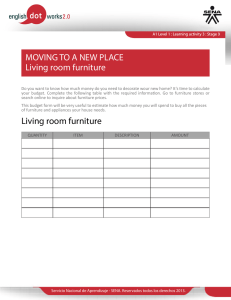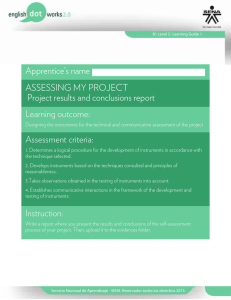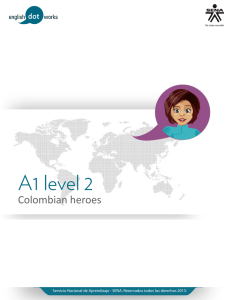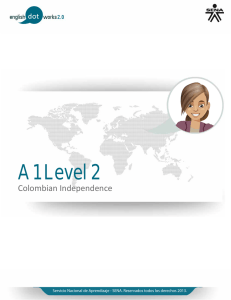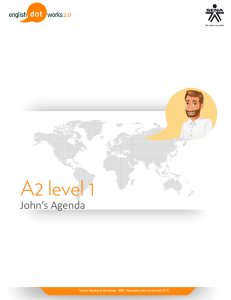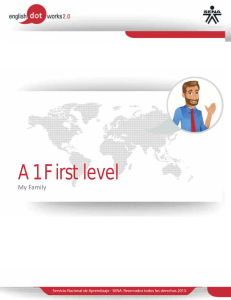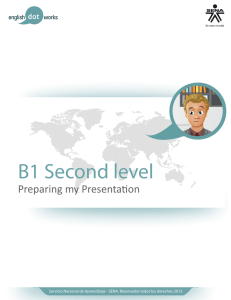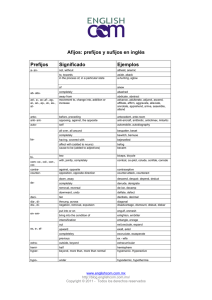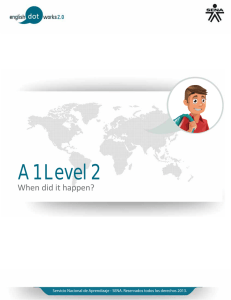B1 Level 2 - Blackboard
Anuncio
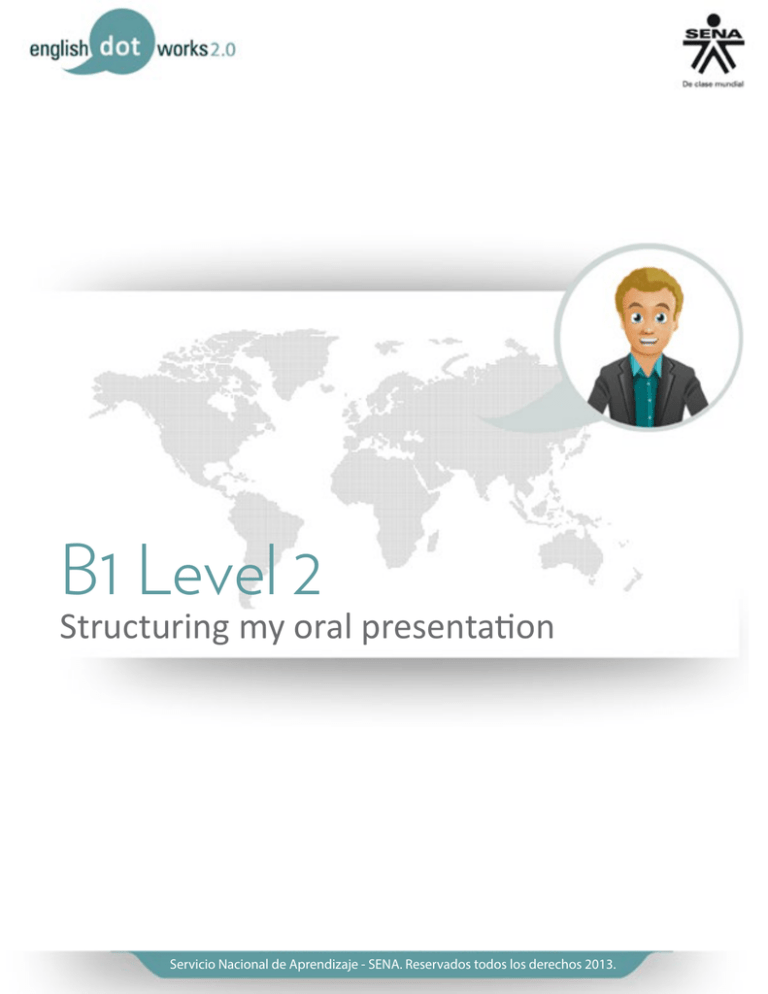
B1 Level 2 Structuring my oral presentation Servicio Nacional de Aprendizaje - SENA. Reservados todos los derechos 2013. Start - Up Welcome! Hello! I’m glad to see you again. Ann Marshal is helping me with my project’s oral presentation. Today, Stacey and I are meeting her, as she’s explaining to us the general structure for an assertive oral presentation. Join us in this learning experience! Start - Up Good afternoon, Ann. It’s nice to meet you. This is my partner, Stacey Howard. I’m glad to meet you too. I hope to be useful in your project presentation. Servicio Nacional de Aprendizaje - SENA. Reservados todos los derechos 2013. 2 /14 Start - Up According to what you have told Anthony, the presentation should contain three parts, right? That’s right, Stacey. Today, we are going to focus on two main topics: planning and structuring the oral presentation. Let’s get down to business! Warm Up When planning an oral presentation, you have to consider five important questions. The first one being: what is the aim of my presentation? Well, in this case, it’d be to get my project accepted by the SENA committee. Servicio Nacional de Aprendizaje - SENA. Reservados todos los derechos 2013. 3 /14 Warm Up Exactly, Anthony. The second question is: what is the title of my presentation? Oh, we haven’t thought of it, really. We’ll have to arrange that. I’m sure you’ll find a good title for your presentation. The third question to consider is: who am I speaking to? Do you mean if we are talking to the decision makers, a group of experts, etc.? Servicio Nacional de Aprendizaje - SENA. Reservados todos los derechos 2013. 4 /14 Warm Up You’re right! This is very important because it sets the purpose and the tone of the speech. Our fourth question is: what are the main points I want to make? Oh, those are related to the objectives of the project, I guess. Sure, they are. But they’re related not only to the objectives of the project as such, but also to the final purpose of the presentation itself. And this question is closely related to the next and final one: what do I want the audience to do after listening to my presentation? I see. That’s like the main purpose, right? To get those people do something, in our case, to convince them to accept our project. You’re becoming experts pretty fast! I like that. Let’s summarize the questions we have learned. Servicio Nacional de Aprendizaje - SENA. Reservados todos los derechos 2013. 5 /14 Warm Up Remember, there are five questions to consider when planning an oral presentation. • What is the aim of my presentation? • What is the title of my presentation? • Who am I speaking to? • What are the main points I want to make? • What do I want the audience to do after listening to my presentation? Servicio Nacional de Aprendizaje - SENA. Reservados todos los derechos 2013. 6 /14 Let’s get inside Let’s get inside Hi, dear apprentices! We already learned the most important factors to bear in mind when planning an oral presentation. Now, we’ll have a look at the way an oral presentation should be structured. Well, as I told you, Anthony, when we talked on the phone, a good speech must be divided into three main parts. A beginning, a body and an ending, right? Servicio Nacional de Aprendizaje - SENA. Reservados todos los derechos 2013. 7 /14 Let’s get inside Well said, Anthony! The introduction or beginning is the most important part to plan ahead because is here where you get the audience’s attention (Storz et al, 2002). And, what is important to bear in mind in this step? It’s very important to introduce yourself: name, position, and company. Then, introduce the topic of your speech, the objectives and the outline that will be followed, so you can be easily traced by the audience. And finally, besides structure, it is helpful to follow the rule: announce what you are going to say, say it, and finally, say what you have said. Being relatively repetitive helps the audience to remember your speech. Servicio Nacional de Aprendizaje - SENA. Reservados todos los derechos 2013. 8 /14 Let’s get inside And, what about the body of the presentation? In the middle or the body of the presentation, it is important to bear in mind five main aspects: The body must be so well structured that you can adjust it to any time restrictions that may occur. • • • • • Content Quantity Sequence of ideas Keeping audience’s attention Signposting where you are The ending of the presentation must include basically four parts: a brief summary of what you showed in your speech; a short conclusion derived from what you said; thanks to the audience and an invitation for questions, suggestions or discussion. Let’s summarize these steps! Beginning: introduce yourself, introduce the topic and outline, and be relatively repetitive. Body: content, quantity, sequence of ideas, keeping audience’s attention, and signposting where you are. Ending: summary, conclusion, thanks, and room for questions. Servicio Nacional de Aprendizaje - SENA. Reservados todos los derechos 2013. 9 /14 Let’s get analyze Let’s get analyze Hello, dear apprentices! Ann Marshall has helped us a lot by teaching us how to structure our oral presentation. A good idea to plan ahead your speech is to draw an outline of your presentation. Join us in discovering how to do it! An outline is a key tool in any presentation. It helps to organize the information you want to present. By following a clear and thorough outline, your audience will understand better your points, and your goal will have more chances to be achieved. (CWS, 2013) Creating an outline is not as easy as it seems in the result. When you look through an outline, you may think that the main points came first and the evidence followed later. It is actually backwards. That’s right, Stacey! Outlines begin with the evidence that’ll support the claims identified later for the speech. Another important fact to bear in mind is not to start writing the outline from the introduction. It can be developed once you have your contents planned. Servicio Nacional de Aprendizaje - SENA. Reservados todos los derechos 2013. 10 /14 Let’s get analyze Evidence Contents Introduction It’s usually ok to stick to three to five points. The more organized your points are, the better they’ll get to the audience. It is also important to think about the time limits and decide what information is the most important to include in the outline. Servicio Nacional de Aprendizaje - SENA. Reservados todos los derechos 2013. 11 /14 Let’s talk Let’s talk Hi, again! When talking to a native English speaker, you may notice that some stress is put sometimes in certain words and sometimes in others. This happens for a reason. Depending on the situation, stress may be due to one of these reasons: adding new information, expressing opinion, showing contrast, and using the verb “can’t”. Let’s see some examples and the way they work. (Cook, 2000) In this case, rain is the new information the speaker is adding. It’s the center of the communicative purpose of the sentence and as so, it is stressed. Now, the stress gives the idea of expressing the opposite of what your senses tell you. This is what we call opinion. Servicio Nacional de Aprendizaje - SENA. Reservados todos los derechos 2013. 12 /14 Let’s talk To show contrast, the speaker puts stress on the words likes and hates, as they’re the ones to be contrasted. Finally, the use of verb can’t is always stressed, as it works as the center of what the speaker wants to communicate. References Cook, Ann. (2000). American Accent Training (2nd edition). New York: Barron’s Educational Series. Storz, Carl et al. (2002). Oral Presentation Skills. Evry, France: Institut National de Télécommunications. The Center for Writing and Speaking. (2013). Basic Speech Outline Format. Decatur, Georgia: Agnes Scott College. Servicio Nacional de Aprendizaje - SENA. Reservados todos los derechos 2013. 13 /14 Credits Credits Pedagogical Direction : Paul Cifuentes Carlos Amaya Direction of Art : Cesar Páez ICT Leadership : Yeison Ospina Quality management : Ingrid Flórez Script composition : Juan David Anduquia Content support : Juan David Anduquia Multimedia Development : Salome Figueroa Ivan Lamprea Daniel Murcia Voices : Equipo Regional San Andrés Servicio Nacional de Aprendizaje - SENA. Reservados todos los derechos 2013. 14 /14
